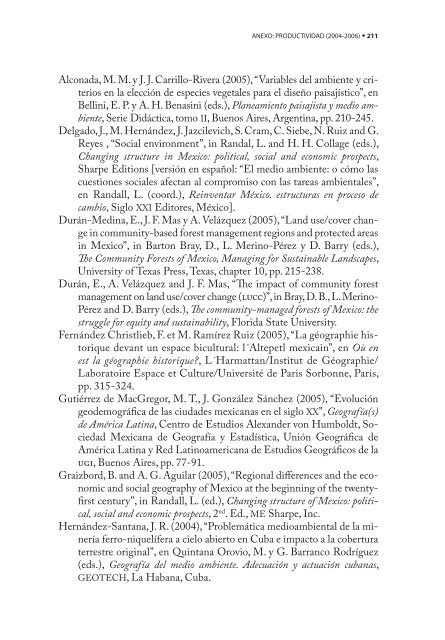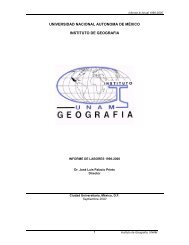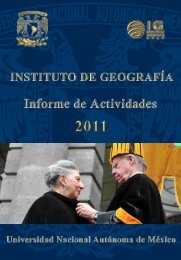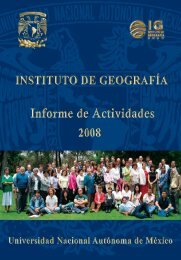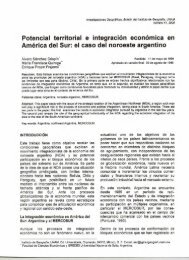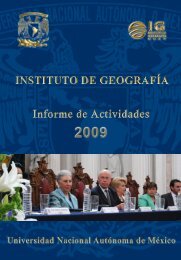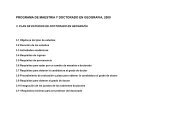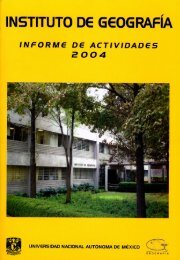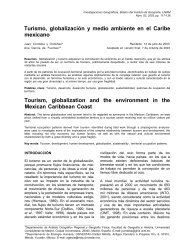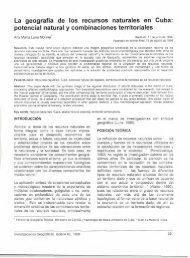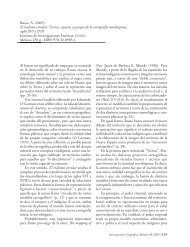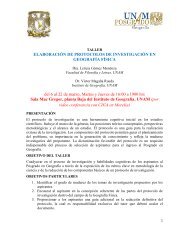210 . INSTITUTO DE GEOGRAFÍA-<strong>UNAM</strong>, INFORME DE ACTIVIDADES 2007Reyna Trujillo, T. y R. López Wilchis (eds.; 2006), Vertebrados <strong>de</strong> México,Depto. <strong>de</strong> Biología-UAM/<strong>Instituto</strong> <strong>de</strong> Geografía-<strong>UNAM</strong>, México.Sánchez, Á. (coord.; 2006), Conocimientos fundamentales <strong>de</strong> Geografía, vol. 1,<strong>UNAM</strong>, México y MacGraw Hill [CD].Sánchez-Crispín, Á., V. Vázquez y O. Reyes (2006), Geografía 1. De Méxicoy <strong>de</strong>l mundo, Castillo, México.Velázquez, A., N. Sosa, J. A. Navarrete y A. Torres (2005), Bases para la conformación<strong>de</strong>l Sistema <strong>de</strong> áreas <strong>de</strong> Conservación <strong>de</strong>l estado <strong>de</strong> Michoacán,Secretaría <strong>de</strong> Urbanismo y Medio Ambiente, Michoacán, México.Vidal, R. (2005), Las regiones climáticas <strong>de</strong> México, Temas Selectos <strong>de</strong> Geografía<strong>de</strong> México (I.2.2), <strong>Instituto</strong> <strong>de</strong> Geografía, <strong>UNAM</strong>, México.Vidal, R. (comp.; 2005), Modificaciones al Sistema <strong>de</strong> Clasificación Climática<strong>de</strong> Köppen, 5ª. ed., corregida y aumentada, <strong>Instituto</strong> <strong>de</strong> Geografía,<strong>UNAM</strong>, México.Villers, M. <strong>de</strong> L. y J. López Blanco (eds.; 2004), Incendios forestales en México:métodos <strong>de</strong> evaluación, Centro <strong>de</strong> Ciencias <strong>de</strong> la Atmósfera, <strong>UNAM</strong>/CONACYT, México.Volkow Fernán<strong>de</strong>z, P., R. Velásquez Pastrana, M. E. Gutiérrez Ruiz y R.González Mesa (2006), Residuos peligrosos biológico-infecciosos. Guíapara su manejo en establecimientos <strong>de</strong> salud, Trillas, México.4. Capítulos en libros internacionales (publicados)Aguilar, A. G. (2004), “Globalization and the restructuring of urban spacein Mexico City”, en Pacione, M. (ed.), Changing Cities, InternationalPerspectives, igu Urban Commission and Strathcly<strong>de</strong> University Publishing,Glasgow, UK, pp. 65-77.Aguilar, A. G. (2005), “Articulación territorial y movilidad laboral en laperiferia regional <strong>de</strong> la Ciudad <strong>de</strong> México”, en De Mattos, C., O. Figueroa,R. Jiménez i Cap<strong>de</strong>vila, A. Orellana y G. Yánez Warner (eds.),Gobernanza, competitividad y re<strong>de</strong>s: la gestión en las ciuda<strong>de</strong>s <strong>de</strong>l siglo XXI,<strong>Instituto</strong> <strong>de</strong> Estudios Urbanos y Territoriales (Colec. Ri<strong>de</strong>al/Eure Libros),Pontificia Universidad Católica <strong>de</strong> Chile, Chile, pp. 65-92.Aguilar, A. G. (2005), “Mexico City and its polycentric regional structure”,en Murayama, Y. y G. Du (eds.), Cities in Global Perspective: diversityand transition, Collage of Tourism, Rikkyo University with IGU UrbanCommission, Tokyo, Japón, pp. 18-29.Aguilar, A. G. and B. Graizbord (2005), “Latin America: a region of sharedloyalities and persistent <strong>de</strong>pen<strong>de</strong>ncies”, in Geyer, H. S., Global regions:core-peripheral population and economic flows.
ANEXO: PRODUCTIVIDAD (2004-2006) . 211Alconada, M. M. y J. J. Carrillo-Rivera (2005), “Variables <strong>de</strong>l ambiente y criteriosen la elección <strong>de</strong> especies vegetales para el diseño paisajístico”, enBellini, E. P. y A. H. Benasini (eds.), Planeamiento paisajista y medio ambiente,Serie Didáctica, tomo II, Buenos Aires, Argentina, pp. 210-245.Delgado, J., M. Hernán<strong>de</strong>z, J. Jazcilevich, S. Cram, C. Siebe, N. Ruiz and G.Reyes , “Social environment”, in Randal, L. and H. H. Collage (eds.),Changing structure in Mexico: political, social and economic prospects,Sharpe Editions [versión en español: “El medio ambiente: o cómo lascuestiones sociales afectan al compromiso con las tareas ambientales”,en Randall, L. (coord.), Reinventar México. estructuras en proceso <strong>de</strong>cambio, Siglo XXI Editores, México].Durán-Medina, E., J. F. Mas y A. Velázquez (2005), “Land use/cover changein community-based forest management regions and protected areasin Mexico”, in Barton Bray, D., L. Merino-Pérez y D. Barry (eds.),The Community Forests of Mexico, Managing for Sustainable Landscapes,University of Texas Press, Texas, chapter 10, pp. 215-238.Durán, E., A. Velázquez and J. F. Mas, “The impact of community forestmanagement on land use/cover change (lucc)”, in Bray, D. B., L. Merino-Pérez and D. Barry (eds.), The community-managed forests of Mexico: thestruggle for equity and sustainability, Florida State University.Fernán<strong>de</strong>z Christlieb, F. et M. Ramírez Ruiz (2005), “La géographie historique<strong>de</strong>vant un espace bicultural: l´Altepetl mexicain”, en Où enest la géographie historique?, L´Harmattan/Institut <strong>de</strong> Géographie/Laboratoire Espace et Culture/Université <strong>de</strong> Paris Sorbonne, Paris,pp. 315-324.Gutiérrez <strong>de</strong> MacGregor, M. T., J. González Sánchez (2005), “Evolucióngeo<strong>de</strong>mográfica <strong>de</strong> las ciuda<strong>de</strong>s mexicanas en el siglo XX”, Geografía(s)<strong>de</strong> América Latina, Centro <strong>de</strong> Estudios Alexan<strong>de</strong>r von Humboldt, SociedadMexicana <strong>de</strong> Geografía y Estadística, Unión Geográfica <strong>de</strong>América Latina y Red Latinoamericana <strong>de</strong> Estudios Geográficos <strong>de</strong> laugi, Buenos Aires, pp. 77-91.Graizbord, B. and A. G. Aguilar (2005), “Regional differences and the economicand social geography of Mexico at the beginning of the twentyfirstcentury”, in Randall, L. (ed.), Changing structure of Mexico: political,social and economic prospects, 2 nd . Ed., ME Sharpe, Inc.Hernán<strong>de</strong>z-Santana, J. R. (2004), “Problemática medioambiental <strong>de</strong> la mineríaferro-niquelífera a cielo abierto en Cuba e impacto a la coberturaterrestre original”, en Quintana Orovio, M. y G. Barranco Rodríguez(eds.), Geografía <strong>de</strong>l medio ambiente. A<strong>de</strong>cuación y actuación cubanas,GEOTECH, La Habana, Cuba.
- Page 1 and 2:
UNIVERSIDAD NACIONAL AUTóNOMA DE M
- Page 3 and 4:
Universidad Nacional Autónoma de M
- Page 5 and 6:
COMISIÓN DICTAMINADORADr. Zoltan d
- Page 7 and 8:
COMISIÓN EVALUADORA PRIDE-PAIPADr.
- Page 9 and 10:
CONTENIDOPRESENTACIÓN 13I. Introdu
- Page 11 and 12:
4. Tesis presentadas 127a) Licencia
- Page 13 and 14:
PRESENTACIÓN . 13PRESENTACIÓNEste
- Page 15 and 16:
INTRODUCCIÓN . 15I. INTRODUCCIÓNE
- Page 17 and 18:
INTRODUCCIÓN . 173. Misión actual
- Page 19 and 20:
PLAN DE DESARROLLO DEL INSTITUTO DE
- Page 21 and 22:
PLAN DE DESARROLLO DEL INSTITUTO DE
- Page 23 and 24:
PERSONAL ACADÉMICO DEL INSTITUTO D
- Page 25 and 26:
PERSONAL ACADÉMICO DEL INSTITUTO D
- Page 27 and 28:
PERSONAL ACADÉMICO DEL INSTITUTO D
- Page 29 and 30:
PERSONAL ACADÉMICO DEL INSTITUTO D
- Page 31 and 32:
PERSONAL ACADÉMICO DEL INSTITUTO D
- Page 33 and 34:
PERSONAL ACADÉMICO DEL INSTITUTO D
- Page 35 and 36:
PERSONAL ACADÉMICO DEL INSTITUTO D
- Page 37 and 38:
PERSONAL ACADÉMICO DEL INSTITUTO D
- Page 39 and 40:
PERSONAL ACADÉMICO DEL INSTITUTO D
- Page 41 and 42:
PERSONAL ACADÉMICO DEL INSTITUTO D
- Page 43 and 44:
PERSONAL ACADÉMICO DEL INSTITUTO D
- Page 45 and 46:
PERSONAL ACADÉMICO DEL INSTITUTO D
- Page 47 and 48:
PERSONAL ACADÉMICO DEL INSTITUTO D
- Page 49 and 50:
PERSONAL ACADÉMICO DEL INSTITUTO D
- Page 51 and 52:
PERSONAL ACADÉMICO DEL INSTITUTO D
- Page 53 and 54:
PERSONAL ACADÉMICO DEL INSTITUTO D
- Page 55 and 56:
PRODUCTIVIDAD . 55Gibson, R. W., M.
- Page 57 and 58:
PRODUCTIVIDAD . 57Carrillo-Rivera,
- Page 59 and 60:
PRODUCTIVIDAD . 59Moncada Maya, J.
- Page 61 and 62:
PRODUCTIVIDAD . 61García, S. y Á.
- Page 63 and 64:
PRODUCTIVIDAD . 63Medina, C., A. Ve
- Page 65 and 66:
PRODUCTIVIDAD . 65Aguirre-Gómez, R
- Page 67 and 68:
PRODUCTIVIDAD . 67Chías Becerril,
- Page 69 and 70:
PRODUCTIVIDAD . 69Padilla y Sotelo,
- Page 71 and 72:
PRODUCTIVIDAD . 71Azuela, L. F.,
- Page 73 and 74:
PRODUCTIVIDAD . 73González Sánche
- Page 75 and 76:
PRODUCTIVIDAD . 75Sánchez Salazar,
- Page 77 and 78:
PRODUCTIVIDAD . 77Cervini-Silva, J,
- Page 79 and 80:
PRODUCTIVIDAD . 79González-Ramíre
- Page 81 and 82:
PRODUCTIVIDAD . 81Orozco Ramírez,
- Page 83 and 84:
PRODUCTIVIDAD . 83Cuevas, G. and J.
- Page 85 and 86:
PRODUCTIVIDAD . 85Gutiérrez-Ruiz,
- Page 87 and 88:
PRODUCTIVIDAD . 87Zavala Hidalgo, J
- Page 89 and 90:
PRODUCTIVIDAD . 89Hernández-Pineda
- Page 91 and 92:
PRODUCTIVIDAD . 91Urquijo Torres, P
- Page 93 and 94:
PRODUCTIVIDAD . 93Tanarro-García,
- Page 95 and 96:
PRODUCTIVIDAD . 95Barrera-Bassols,
- Page 97 and 98:
PRODUCTIVIDAD . 97Larrazábal, A. (
- Page 99 and 100:
PRODUCTIVIDAD . 99Carmona, E., “G
- Page 101 and 102:
PRODUCTIVIDAD . 10113. Nuevo Atlas
- Page 103 and 104:
PRODUCTIVIDAD . 103Agroclimatologí
- Page 105 and 106:
PRODUCTIVIDAD . 105Instituto de Inv
- Page 107 and 108:
ACTUALIZACIÓN . 107V. ACTUALIZACI
- Page 109 and 110:
ACTUALIZACIÓN . 109(IMGA), United
- Page 111 and 112:
ACTUALIZACIÓN . 111• Orta Pérez
- Page 113 and 114:
DOCENCIA Y FORMACIÓN DE RECURSOS H
- Page 115 and 116:
DOCENCIA Y FORMACIÓN DE RECURSOS H
- Page 117 and 118:
DOCENCIA Y FORMACIÓN DE RECURSOS H
- Page 119 and 120:
DOCENCIA Y FORMACIÓN DE RECURSOS H
- Page 121 and 122:
DOCENCIA Y FORMACIÓN DE RECURSOS H
- Page 123 and 124:
DOCENCIA Y FORMACIÓN DE RECURSOS H
- Page 125 and 126:
DOCENCIA Y FORMACIÓN DE RECURSOS H
- Page 127 and 128:
DOCENCIA Y FORMACIÓN DE RECURSOS H
- Page 129 and 130:
DOCENCIA Y FORMACIÓN DE RECURSOS H
- Page 131 and 132:
DOCENCIA Y FORMACIÓN DE RECURSOS H
- Page 133 and 134:
DOCENCIA Y FORMACIÓN DE RECURSOS H
- Page 135 and 136:
DOCENCIA Y FORMACIÓN DE RECURSOS H
- Page 137 and 138:
DOCENCIA Y FORMACIÓN DE RECURSOS H
- Page 139 and 140:
DOCENCIA Y FORMACIÓN DE RECURSOS H
- Page 141 and 142:
DOCENCIA Y FORMACIÓN DE RECURSOS H
- Page 143 and 144:
DOCENCIA Y FORMACIÓN DE RECURSOS H
- Page 145 and 146:
DOCENCIA Y FORMACIÓN DE RECURSOS H
- Page 147 and 148:
DOCENCIA Y FORMACIÓN DE RECURSOS H
- Page 149 and 150:
DOCENCIA Y FORMACIÓN DE RECURSOS H
- Page 151 and 152:
DOCENCIA Y FORMACIÓN DE RECURSOS H
- Page 153 and 154:
DOCENCIA Y FORMACIÓN DE RECURSOS H
- Page 155 and 156:
DOCENCIA Y FORMACIÓN DE RECURSOS H
- Page 157 and 158:
DOCENCIA Y FORMACIÓN DE RECURSOS H
- Page 159 and 160: VINCULACIÓN . 159VII. VINCULACIÓN
- Page 161 and 162: VINCULACIÓN . 161Posgrado Centroam
- Page 163 and 164: VINCULACIÓN . 163• Universidad T
- Page 165 and 166: INTERCAMBIO ACADÉMICO . 1651. Prof
- Page 167 and 168: PROGRAMA EDITORIAL . 167IX. Program
- Page 169 and 170: PROGRAMA EDITORIAL . 169Igualmente
- Page 171 and 172: BIBLIOTECA-MAPOTECA . 171• Actual
- Page 173 and 174: BIBLIOTECA-MAPOTECA . 1732. Procesa
- Page 175 and 176: BIBLIOTECA-MAPOTECA . 175• Reunio
- Page 177 and 178: BIBLIOTECA-MAPOTECA . 177• Orient
- Page 179 and 180: BIBLIOTECA-MAPOTECA . 17912. Horari
- Page 181 and 182: SECRETARÍA ADMINISTRATIVA . 181Xi.
- Page 183 and 184: SECRETARÍA ADMINISTRATIVA . 183Est
- Page 185 and 186: SECRETARÍA ADMINISTRATIVA . 185Ing
- Page 187 and 188: SECRETARÍA ADMINISTRATIVA . 187IN-
- Page 189 and 190: SECRETARÍA ADMINISTRATIVA . 189Pro
- Page 191: AnexoProductividad(2004-2006)
- Page 194 and 195: 194 . INSTITUTO DE GEOGRAFÍA-UNAM,
- Page 196 and 197: 196 . INSTITUTO DE GEOGRAFÍA-UNAM,
- Page 198 and 199: 198 . INSTITUTO DE GEOGRAFÍA-UNAM,
- Page 200 and 201: 200 . INSTITUTO DE GEOGRAFÍA-UNAM,
- Page 202 and 203: 202 . INSTITUTO DE GEOGRAFÍA-UNAM,
- Page 204 and 205: 204 . INSTITUTO DE GEOGRAFÍA-UNAM,
- Page 206 and 207: 206 . INSTITUTO DE GEOGRAFÍA-UNAM,
- Page 208 and 209: 208 . INSTITUTO DE GEOGRAFÍA-UNAM,
- Page 212 and 213: 212 . INSTITUTO DE GEOGRAFÍA-UNAM,
- Page 214 and 215: 214 . INSTITUTO DE GEOGRAFÍA-UNAM,
- Page 216 and 217: 216 . INSTITUTO DE GEOGRAFÍA-UNAM,
- Page 218 and 219: 218 . INSTITUTO DE GEOGRAFÍA-UNAM,
- Page 220 and 221: 220 . INSTITUTO DE GEOGRAFÍA-UNAM,
- Page 222 and 223: 222 . INSTITUTO DE GEOGRAFÍA-UNAM,
- Page 224 and 225: 224 . INSTITUTO DE GEOGRAFÍA-UNAM,
- Page 226 and 227: 226 . INSTITUTO DE GEOGRAFÍA-UNAM,
- Page 228 and 229: 228 . INSTITUTO DE GEOGRAFÍA-UNAM,
- Page 230 and 231: 230 . INSTITUTO DE GEOGRAFÍA-UNAM,
- Page 232 and 233: 232 . INSTITUTO DE GEOGRAFÍA-UNAM,
- Page 234 and 235: 234 . INSTITUTO DE GEOGRAFÍA-UNAM,
- Page 236 and 237: 236 . INSTITUTO DE GEOGRAFÍA-UNAM,
- Page 238 and 239: 238 . INSTITUTO DE GEOGRAFÍA-UNAM,
- Page 240 and 241: 240 . INSTITUTO DE GEOGRAFÍA-UNAM,
- Page 242 and 243: 242 . INSTITUTO DE GEOGRAFÍA-UNAM,
- Page 244 and 245: 244 . INSTITUTO DE GEOGRAFÍA-UNAM,
- Page 246 and 247: 246 . INSTITUTO DE GEOGRAFÍA-UNAM,
- Page 248 and 249: 248 . INSTITUTO DE GEOGRAFÍA-UNAM,
- Page 250 and 251: 250 . INSTITUTO DE GEOGRAFÍA-UNAM,
- Page 252 and 253: 252 . INSTITUTO DE GEOGRAFÍA-UNAM,
- Page 254 and 255: 254 . INSTITUTO DE GEOGRAFÍA-UNAM,
- Page 256 and 257: 256 . INSTITUTO DE GEOGRAFÍA-UNAM,
- Page 258 and 259: 258 . INSTITUTO DE GEOGRAFÍA-UNAM,
- Page 260 and 261:
260 . INSTITUTO DE GEOGRAFÍA-UNAM,
- Page 262 and 263:
262 . INSTITUTO DE GEOGRAFÍA-UNAM,
- Page 264 and 265:
264 . INSTITUTO DE GEOGRAFÍA-UNAM,
- Page 266 and 267:
266 . INSTITUTO DE GEOGRAFÍA-UNAM,
- Page 268 and 269:
268 . INSTITUTO DE GEOGRAFÍA-UNAM,
- Page 270 and 271:
270 . INSTITUTO DE GEOGRAFÍA-UNAM,
- Page 272 and 273:
272 . INSTITUTO DE GEOGRAFÍA-UNAM,
- Page 274 and 275:
274 . INSTITUTO DE GEOGRAFÍA-UNAM,
- Page 276 and 277:
276 . INSTITUTO DE GEOGRAFÍA-UNAM,
- Page 278 and 279:
278 . INSTITUTO DE GEOGRAFÍA-UNAM,


